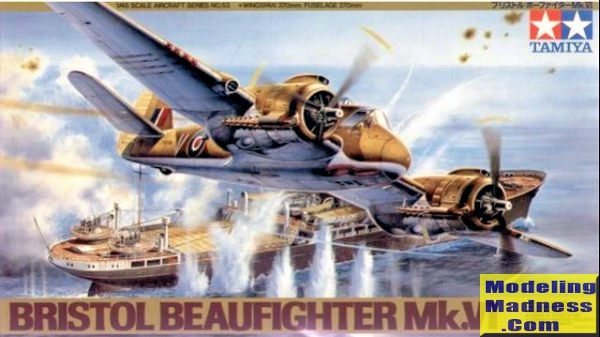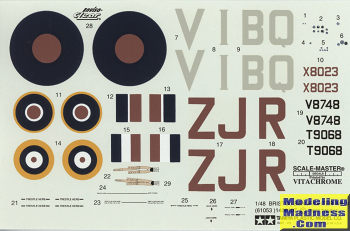
| KIT #: | 61053 |
| PRICE: | 2800 yen SRP |
| DECALS: | Three options |
| REVIEWER: | Scott Van Aken |
| NOTES: | 1997 tooling |

| HISTORY |
The Bristol Type 156 Beaufighter (often referred to simply as the "Beau") is a multi-role aircraft developed during the Second World War by the Bristol Aeroplane Company in the United Kingdom. It was originally conceived as a heavy fighter variant of the Bristol Beaufort bomber. Upon its entry to service, the Beaufighter proved to be well suited to the night fighter role, for which the Royal Air Force (RAF) initially deployed the type during the height of the Battle of Britain, in part due to its large size allowing it to accommodate both heavy armaments and early airborne interception radar without major performance penalties.
As its wartime service continued, the Beaufighter was used in many different roles; receiving the nicknames Rockbeau for its use as a rocket-armed ground attack aircraft, and Torbeau in its role as a torpedo bomber against Axis shipping, in which it came to replace the Beaufort which had preceded it. In later operations, it served mainly as a maritime strike/ground attack aircraft, RAF Coastal Command having operated the largest number of Beaufighters amongst all other commands at one point. The Royal Australian Air Force (RAAF) also made extensive use of the type in the maritime anti-shipping role, such as during the Battle of the Bismarck Sea.
The Beaufighter saw extensive service during the war with the RAF (59 squadrons), Fleet Air Arm (15 squadrons), RAAF (seven squadrons), Royal Canadian Air Force (four squadrons), United States Army Air Forces (four squadrons), Royal New Zealand Air Force (two squadrons), South African Air Force (two squadrons) and Polskie Siły Powietrzne (Free Polish Air Force; one squadron). In addition, variants of the Beaufighter were also manufactured in Australia by the Department of Aircraft Production (DAP); such aircraft are sometimes referred to by the name DAP Beaufighter.
| THE KIT |
The release of this kit by Tamiya put the brakes on a similar kit being developed by Accurate Miniatures and is often considered to be one of the reasons for AC's initial demise as considerable effort had already gone into development. Like every Tamiya kit I've seen in the last 30 or so years, this one is superbly molded with crisp engraved panel line detailing and clean moldings.
There is a well appointed cockpit and gunner/radar operator's position with decals for not only instruments but also seat harness. Crew figures are provided for those who like to include these in their models. Sidewall detail is nicely done as well. The fin is a two halves deal and actually slides into position at the back of the completed fuselage.
Winds are five pieces with full upper wing halves and partial lower wing sections. A fifth piece incorporated the lower fuselage section along with the lower wing and lower engine nacelles. The Beaufighter had somewhat complex main landing gear, but Tamiya have done a fine job of duplicating this. I should mention that if one wants to build a rocket armed version, that decision needs to be made prior to assembling the wings. The rockets come on a 'pack' that once assembled, fits en masse into holes you have opened in the lower wings. Only one of the three options is rocket armed.
For engines, you get a face that fits onto the cowl flap
section which then fits on the nacelle. A single casting of the cowling fits
over this and each of the 'porcupine' exhaust is two halves assembled together.
I'm sure someone does resin replacements for these. The Mk.VI had the tailplanes
with dihedral and those are single pieces that fit into the rear fuselage. There
are the usual mass of antennas and such as well as a choice of a rear seat glass
with or without a gun mount. If doing the night fighter you will have hopefully
opened the holes in the leading edge of the wing for this variant before
assembling the wing.

Instructions have your usual Tamiya paint references and are typically well drawn. Tamiya offers three markings options, all different. The box art plane in desert camo is with 272 squadron based on Malta. This option is the one that uses the rockets. Then there is a standard Temperate scheme plane from 96 squadron based in Scotland. This does not have the yellow leading edge ID markings. Finally, an all black night fighter from 600 squadron. The decals are nicely printed and one will need to use hot water for these to function properly.
| CONCLUSIONS |
In all, it does build into a very nice model. I've seen several completed over the years and there are some examples here in MM. A quick search finds that these kits are generally selling in the $30-$40.00 range, though some can be found for less.
| REFERENCES |
https://en.wikipedia.org/wiki/Bristol_Beaufighter
September 2017 Copyright ModelingMadness.com. All
rights reserved. If you would like your product reviewed fairly and fairly quickly, please
contact the editor
or see other details in the
Note to
Contributors. Back to the Main Page
Back to the Review
Index Page
Back to the Previews Index Page